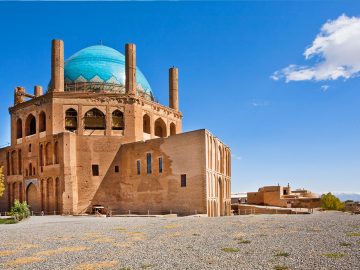Zanjan province including Zanjan city as its center and eight counties with an area of 21,773 square kilometers ranks the 20th largest province of Iran. Its neighboring provinces comprise West Azerbaijan, East Azerbaijan, Ardabil, Gilan, Qazvin, Hamedan, and Kurdistan. Incorporating about 1.5 percent of the total population of the country, Zanjan’s residents are mostly Turks who speak Azerbaijani Turkish.
The province has a mountainous nature that surrounds parts of the Alborz, Talesh, and Qaflankuh Mountains. In the mountainous parts and lower altitude areas, the province has cold and semi-humid climates, respectively.

The archaeological excavations carried out in the area show that the history of the province dates back to prehistoric times. For example, the findings in Galjik Cave approve a human settlement with a history of 16 to 30 thousand before the birth of Christ. The ancient human-made objects including open-air fire temples belonging to the Parthian (247 B.C.- 224 A.D.) and Sassanid (224-651 A.D.) Empires indicate that the valley of Qizil Üzan and Zanjan-rud Rivers were popular in ancient times.
Following the attack of Hulagu Khan to Ismaili Castles and the collapse of the Abbasid caliphate (750-1258) in Baghdad, Iran including Soltaniyeh (Zanjan province), Maragheh, and Tabriz cities became the center of the Ilkhanate government (1256-1335). However, Zanjan was first destroyed upon the invasion of Mongol but Oljaitu is known as Muhammad Khodabandeh, the most famous king of the Ilkhanate dynasty, built the historical city of Soltaniyeh near Zanjan.
Zanjan province benefits from a diversity of attractions encompassing natural and cultural/historical resources.
The Soltaniyeh Dome, which has been registered on the UNESCO World Heritage List, is the most salient historical work in the province.
Chalabioghlou Mausoleum, Dashkasan Temple, numerous caves with historic engravings, Katale Khor Cave, Mah-Neshan colorful Mountains, Zanjan’s historical bazaar, bridges, castles, and caravanserais are among the tourist attractions of this province. Also, Zanjan’s handicrafts include handmade steel knives, filigree, traditional shoe, and metalworking, among which the most famous ones are steel knives.
The eatable souvenirs of the province include almond, walnut, and grape. Its native cuisines are Suti Aush (rice pudding), sour Aush, Yaaq Shurba (a kind of soup) Qara Shurba (boiled meat and bread), Irdak (a mixture of flour and milk), and different types of meals made of meat. Finally, Shahab Al-Din Sohrevardi (philosopher) and Hossein Monzavi (contemporary poet) can be considered the province’s prominent figures.


